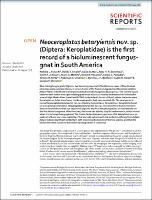Please use this identifier to cite or link to this item:
https://hdl.handle.net/20.500.12202/9620| Title: | Neoceroplatus betaryiensis nov. sp. (Diptera: Keroplatidae) is the first record of a bioluminescent fungusgnat in South America |
| Authors: | Falaschi, Rafaela L. Amaral, Danilo T. Santos, Isaias Domingos, Adão H. R. Johnson, Grant A. Martins, Ana G. S. Viroomal, Imran B. Pompéia, Sérgio L. Mirza, Jeremy D. Oliveira, Anderson G. Bechara, Etelvino J. H. Viviani, Vadim R. Stevani, Cassius V. 0000-0003-1752-0726 |
| Keywords: | Blue shining fungus gnats (Diptera) Neoceroplatus betaryiensis nov. sp. (Diptera: Keroplatidae: Keroplatinae: Keroplatini) luciferin-luciferase bioluminescence spectrum |
| Issue Date: | 2019 |
| Publisher: | Nature Publishing Group |
| Citation: | Falaschi, R. L., Amaral, D. T., Santos, I., Domingos, A. H. R., Johnson, G. A., Martins, A. G. S., Viroomal, I. B., Pompéia, S. L., Mirza, J. D., Oliveira, A. G., Bechara, E. J. H., Viviani, V. R., & Stevani, C. V. (2019). Neoceroplatus betaryiensis nov. sp. (Diptera: Keroplatidae) is the first record of a bioluminescent fungus-gnat in South America. Scientific Reports, 9(1). https://doi.org/10.1038/s41598-019-47753-w |
| Series/Report no.: | Scientific Reports;9 |
| Abstract: | Blue shining fungus gnats (Diptera) had been long reported in the Waitomo caves of New Zealand (Arachnocampa luminosa Skuse), in stream banks of the American Appalachian Mountains (Orfelia fultoni Fisher) in 1939 and in true spore eating Eurasiatic Keroplatus Bosc species. This current report observes that similar blue light emitting gnat larvae also occur nearby the Betary river in the buffer zone of High Ribeira River State Park (PETAR) in the Atlantic Forest of Brazil, where the larvae were found when on fallen branches or trunks enveloped in their own secreted silk. The new species is named Neoceroplatus betaryiensis nov. sp. (Diptera: Keroplatidae: Keroplatinae: Keroplatini) based on a morphological analysis. Neoceroplatus betaryiensis nov. sp. larvae emit blue bioluminescence that can be seen from their last abdominal segment and from two photophores located laterally on the first thoracic segment. When touched, the larvae can actively stop its luminescence, which returns when it is no longer being agitated. The in vitro bioluminescence spectrum of N. betaryiensis nov. sp. peaks at 472 nm, and cross-reactivity of hot and cold extracts with the luciferin-luciferase from Orfelia fultoni indicate significant similarity in both enzyme and substrate of the two species, and that the bioluminescence system in the subfamily Keroplatinae is conserved. |
| Description: | Scholarly article / Open access |
| URI: | https://hdl.handle.net/20.500.12202/9620 |
| ISSN: | 2045-2322 |
| Appears in Collections: | Stern College for Women -- Faculty Publications |
Files in This Item:
| File | Description | Size | Format | |
|---|---|---|---|---|
| Oliveira OA 2019 Neoceroplarus.pdf | 858.97 kB | Adobe PDF |  View/Open |
This item is licensed under a Creative Commons License

